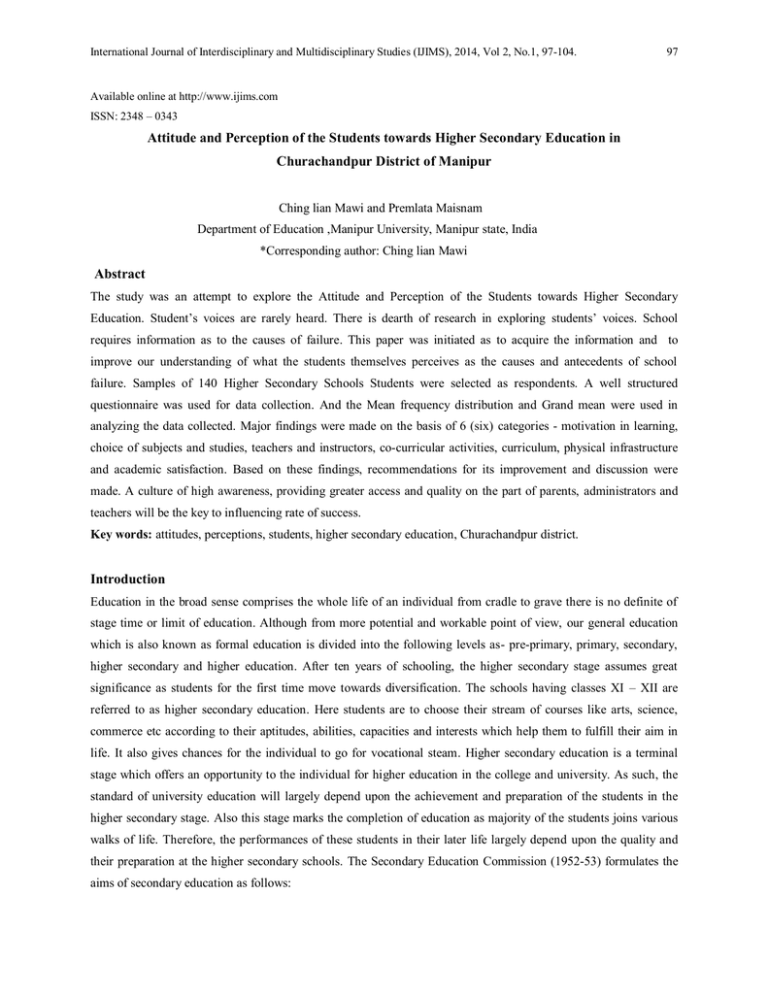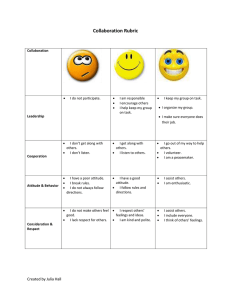Attitude and Perception of the Students towards Higher Secondary
advertisement

International Journal of Interdisciplinary and Multidisciplinary Studies (IJIMS), 2014, Vol 2, No.1, 97-104. 97 Available online at http://www.ijims.com ISSN: 2348 – 0343 Attitude and Perception of the Students towards Higher Secondary Education in Churachandpur District of Manipur Ching lian Mawi and Premlata Maisnam Department of Education ,Manipur University, Manipur state, India *Corresponding author: Ching lian Mawi Abstract The study was an attempt to explore the Attitude and Perception of the Students towards Higher Secondary Education. Student‟s voices are rarely heard. There is dearth of research in exploring students‟ voices. School requires information as to the causes of failure. This paper was initiated as to acquire the information and to improve our understanding of what the students themselves perceives as the causes and antecedents of school failure. Samples of 140 Higher Secondary Schools Students were selected as respondents. A well structured questionnaire was used for data collection. And the Mean frequency distribution and Grand mean were used in analyzing the data collected. Major findings were made on the basis of 6 (six) categories - motivation in learning, choice of subjects and studies, teachers and instructors, co-curricular activities, curriculum, physical infrastructure and academic satisfaction. Based on these findings, recommendations for its improvement and discussion were made. A culture of high awareness, providing greater access and quality on the part of parents, administrators and teachers will be the key to influencing rate of success. Key words: attitudes, perceptions, students, higher secondary education, Churachandpur district. Introduction Education in the broad sense comprises the whole life of an individual from cradle to grave there is no definite of stage time or limit of education. Although from more potential and workable point of view, our general education which is also known as formal education is divided into the following levels as- pre-primary, primary, secondary, higher secondary and higher education. After ten years of schooling, the higher secondary stage assumes great significance as students for the first time move towards diversification. The schools having classes XI – XII are referred to as higher secondary education. Here students are to choose their stream of courses like arts, science, commerce etc according to their aptitudes, abilities, capacities and interests which help them to fulfill their aim in life. It also gives chances for the individual to go for vocational steam. Higher secondary education is a terminal stage which offers an opportunity to the individual for higher education in the college and university. As such, the standard of university education will largely depend upon the achievement and preparation of the students in the higher secondary stage. Also this stage marks the completion of education as majority of the students joins various walks of life. Therefore, the performances of these students in their later life largely depend upon the quality and their preparation at the higher secondary schools. The Secondary Education Commission (1952-53) formulates the aims of secondary education as follows: International Journal of Interdisciplinary and Multidisciplinary Studies (IJIMS), 2014, Vol 2, No.1, 97-104. 98 1.Development of qualities essential for creative citizenship: This includes the development in the students of secondary schools of those habits, attitudes and qualities of character which are essential for creative citizenship in a democratic society. Among these qualities, which are to be fostered through curricular and co-curricular activities in secondary schools are:- the capacity for clear thinking, the scientific attitude of mind, receptivity to new ideas, respect for the dignity and worth of every individual, ability to live harmoniously with one another, a sense of true patriotism and a sense of world citizenship. 2.Promotion of vocation efficiency: This involves not only the creation of a new attitude to work and appreciation of the dignity of manual labour but also the development of student‟s technical skills and efficiency through greater emphasis on craft and productive work and also the diversification of courses at the secondary stage. 3.Development of personality: This implies cultivation of student‟s literacy, artistic and cultural interest for a further development of their personalities. This means the provisions of subjects like art, craft, music, dancing and hobbies in the secondary school curricula. 4.Training for leadership: This means the training of students, who on the completion of secondary stage would be able to assume the responsibility at the intermediate level or in their later life. Higher secondary education is a crucial stage as it generally covers the period of adolescent (16-18years ), the most vital stage of anybody‟s life that bring about colorful changes in all directions. Dealing with adolescent at a very critical moment of their lives, higher secondary education has an important missions; to provide youths with the necessary knowledge and skills, to live in an advanced technological society, to prepare them for the world of work and also for future learning, to foster social cohesion and transmit the cultural and ethical values necessary for active participation in a democratic society. Therefore, it is absolutely essential to strengthen this stage by improving the quality in a significant way. Chamber(1999) and Ombui (2012) advanced the argument that attitudes of students towards a subject have an implication on their academic improvement. If students have a positive attitude towards a subject, there are high chances of them performing well in the subject. American Sociological Association (2011) linking extracurricular programming to academic achievement analyzes data from the national educational longitudinal study of 1988 to test the effect of participation in extra co-curricular activities on high school achievement. It also explores potential mediating mechanisms that link such participation to academic success. The result shows that participation in some activities improves achievement, while participation in others diminishes achievement. Participation in interscholastic sports promotes students development and social ties among students, parents and schools, and these benefits expand the positive effect of participation of achievement. Gillian Roehring‟s (2006) study focused on constraints related to the implementation of inquiry based instruction in both secondary and undergraduate classrooms. The research agenda has been focused on the constraints experienced by beginning teachers as they implement enquiry based instruction in their classroom and how these constraints can be mitigated through participation in a science focused induction programme. Usha (1989) revealed that teachers job satisfaction, student‟s instructional perception and school climate are positively and significantly correlated with each other on International Journal of Interdisciplinary and Multidisciplinary Studies (IJIMS), 2014, Vol 2, No.1, 97-104. 99 the basis of different types of administrative styles. The highest agreement was seen with the democratic style as well as the laissez-faire style, where as the lowest agreement was seen with the autocratic style. Hence, the democratic style and the laissez faire style can be located at the negative points of administrative style. Budhdev (1989) studied the attitude of pupils towards various school subjects. He found that while girls showed an overall positive attitude towards various subjects, boys had a better attitude towards science subjects. The study also reveals that the high intelligent groups of pupils (regardless of genders) had a better attitude towards mathematics and English than their low intelligence counterparts. Tripathi (1990) found that academic performance was negatively correlated with self concept and levels of aspiration. Besides, no such relationship was observed between academic performance and academic motivation except in one of its dimension i.e., desire for self improvement. Ghalsasi (1988) identified trends and patterns regarding the study skills of secondary pupils and prepared a programme for developing/strengthening the desire habits/skills and found that students had no definite idea about the purpose of studying/objective of schooling, their responses at best covered „better jobs‟, „social status‟ etc. Bose (1965) made an investigation on educational facilities available in the higher secondary schools of west Bengal and revealed that (i) existing conditions did not allow the students adequate freedom of choice of subjects (ii) absence of adequate pool of competent and devoted teachers was one of greatest impediments to the successful implementation of course (iii) library facilities were very poor in many of the school (iv) regular periodical examinations were not much stressed. National Economics and Social Development Board (1976) in “The policies and Targets of the Third Plan” demanded (i) to improve and expand secondary level of education according to the requirement of middle level manpower with particular emphasis on the province, and to improve and broaden the curriculum, so that students will have more opportunity to select subjects of their choice (ii)to increase efficiency and reduce wastage, particularly at the upper secondary level and (iii)to improve private school by giving special emphasis to improve teaching. Operational definition of the term used Attitude and perception An attitude is a favourable or unfavourable condition of something. Attitudes are generally positive or negatives of a person, place, thing, or event. People can also be conflicted or ambivalent toward an object, meaning that they simultaneously possess both positive and negative attitudes towards that particular thing, place and person for the present study. Perception is the process of attaining awareness or understanding of the environment by organizing and interpreting sensory information. For the present study, perception means the awareness of higher secondary education among students. Higher secondary education It means the education after the lower secondary stage. The present study refers from classes XI to XII for general education of private and government higher secondary schools affiliated under the Council of Higher Secondary schools, Manipur. Churachandpur District International Journal of Interdisciplinary and Multidisciplinary Studies (IJIMS), 2014, Vol 2, No.1, 97-104. 100 Churachandpur District is situated in the South – West part of Manipur State in India. It is bounded by Senapati District in the North, Bishnupur and Chandel District in the East, Assam and Mizoram State in the West and Myanmar on the South. The total geographical area of Churachandpur District is 4, 570 sq.km. it lies between 23 o 55‟N to 24o 30‟ N latitudes and between 92o 59‟ E to 93o 50‟ E longitudes. The topography of the District is hilly. Methodology Research designing The descriptive research design was used in order to study the attitude and perception of the students of the 7(seven) higher secondary schools in Churachandpur district of Manipur. Population and sampling The population of the students comprised of all the students in the 7(seven) higher secondary schools. The investigator selected 140 students i.e., 20 from each school during the session 2013-14, with the help of purposive random sampling technique. Instruments and procedure No published instrument was found suitable for the study. So, a self structured questionnaire/scale was used to collect data for the study. The instrument used a four point Likert - type scale for rating the response options. Reliability and validity was established with the help of statistical techniques and in consultation with the experts of the concerned field. Scoring was done by assigning 4 marks to Strongly Agree (SA), 3 marks to Agree (A), 2 marks to Strongly Disagree (SD), 1 mark to Disagree (D) respectively for the positive statements the scoring procedure is reversed for the negative statements. For decision to be made, the mean of the scaling point was computed as 4+3+2+1 = 2.5 4 Therefore, the response with means 2.5 and above was regarded as agree while less than 2.5 would be disagree. The data collected for the study were analyzed using mean and grand mean to answer the questions. Results Table 1: Mean ratings of the response of the students’ attitudes towards level of motivation in studies. S/N ITEMS (1) I really want to learn and do my best (2) I often bunk those boring classes (3) I will be able to keep up with other SA SD D EFX F 24 5 503 140 3.59 agreed 60 189 24 314 140 2.24 disagreed 280 144 24 10 458 140 3.27 30 144 312 140 2.22 450 41 A 54 X EX Remark 2.83 agreed students on this course of study (4) I tried my best but it doesn‟t help me. 50 88 Table 1 above showed that level of students‟ motivation in studies recorded above the acceptable level of 2. disagreed International Journal of Interdisciplinary and Multidisciplinary Studies (IJIMS), 2014, Vol 2, No.1, 97-104. 101 Table 2: Mean ratings of the response of the students on the choice of subjects and learning. S/N ITEMS SA A SD 196 90 42 400 50 448 70 D EFX F X EX Remark 40 368 140 2.62 agreed 12 44 206 140 1.47 disagreed 51 16 3 518 140 3.7 46 84 76 276 140 1.97 (1) I chose my stream of subjects due to parents and peer influence (2) I chose subjects that suits my personal interest (3) Students should take responsibility for their own learning 2.44 agreed (4) Attaining knowledge and goods marks in exam depends upon the teacher disagreed From table 2 above, it was shown that students‟ response on personal choice of subjects and learning reached below the acceptable level of 2. Table 3: Mean ratings of the response of the students’ on teachers and instructors S/N ITEMS SA A SD D EFX F X 56 247 140 1.76 EX Remark (1) There are adequate trained teachers and instructors in my school (2) Teachers are not committed to teaching 68 224 102 120 21 18 35 397 140 disagreed 2.83 agreed (3) Teachers teach well with much interesting and subject mastery 252 141 46 7 446 140 3.18 80 108 12 8 208 140 1.48 2.31 agreed (4) I am usually bored with what is taught in the class disagreed Table 3 above indicated that the grand mean response of the students was below the acceptable level of 2.5 Table 4: Mean ratings of the response of the students on co-curricular activities S/N ITEMS SA A SD D EFX F X 10 463 140 3.30 EX Remark (1) My school often conducts co-curricular activities that are interesting to students 280 135 26 agreed (2) I find co-curricular activities boring as it affects my studies 466 74 60 148 328 140 2.34 disagreed 69 60 63 80 272 140 1.94 2.58 disagreed (3) Students in my school get to be creative and used their abilities in school (4) Students are often disruptive and get away with not doing their work 200 99 60 27 386 140 2.75 agreed International Journal of Interdisciplinary and Multidisciplinary Studies (IJIMS), 2014, Vol 2, No.1, 97-104. 102 From the above table 4, it was shown that students‟ response towards co-curricular activities was above the acceptable level of 2.5 Table 5: Mean ratings of the response of the students on curriculum S/N ITEMS SA A SD D EFX F X 80 54 33 88 255 140 1.82 200 72 70 31 373 140 292 60 28 33 413 140 2.95 34 171 180 406 140 2.9 EX Remark (1) The subjects which I learn are according to my needs and interests disagreed (2) The subjects lacks values are they are not related to life and work (3) Most subjects covers variety of experiences (4) Most subjects focus only job- oriented 21 2.66 agreed 2.58 agreed agreed Table 5 results of the items above showed that grand mean of students response towards curriculum was above the acceptable level of 2.5 Table 6: Mean ratings of the response of the students on physical infrastructure S/N ITEMS SA A SD D EFX F X EX Remark 60 80 39 108 287 140 2.05 disagreed 340 90 10 20 460 140 3.28 agreed 80 90 18 36 224 140 1.6 2.40 disagreed 102 66 27 379 140 2.7 agreed (1) My school is flexible enough to accommodate a large number of students (2) I think my class-room is overcrowded (3) There are sufficient welfare services for students in my school (4) There is inadequate infrastructure for students and teachers in my school 184 Table 6 above indicated that grand mean response of students towards physical infrastructure was below the acceptable level of 2.5. Table 7: Mean ratings of the response of the students on the level of academic satisfaction S/N ITEMS SA A SD D EFX F X EX Remark 73 80 75 8 236 140 1.68 disagreed 280 90 30 25 425 140 3.03 agreed (1) I am satisfied with my performance in the class tests/weekly tests/monthly tests etc. (2) I think obtaining pass mark and required attendance is just required for passing out (3) After + 2 education, I opted to go for job training than a three year degree course 100 42 27 40 209 140 1.49 2.20 disagreed 111 38 39 368 140 2.62 agreed (4) I think learners are too young to benefit fully from Higher Secondary Education 180 International Journal of Interdisciplinary and Multidisciplinary Studies (IJIMS), 2014, Vol 2, No.1, 97-104. 103 Table 7 results of the items indicated that students levels of satisfaction towards academic performance was at low level as it contained grand mean level of response below the acceptable level of 2.5. Discussion The purpose of the present study was to investigate the attitude and perception of the students towards higher secondary education in Churachandpur district of Manipur. The overall obtained results indicated that student showed an unfavourable attitude and perception towards higher secondary education. The findings of the study on the items for motivational level of interests in studies implied at high level as students want to learn and do their best. Also, they had a confidence in being able to keep up with other students in their course of studies. The study also revealed that parents and peer influence towards their education could develop a negative attitude towards their education. Students should be given full freedom in their choice of subjects on the basis of their personal interests that suits them so that it could bore fruitful results in their education and later life. The findings also revealed that there is shortage of trained teachers and instructors in the higher secondary schools. Adequate steps as in the area of in-service training programme to teachers should be taken. Teachers ought to create and develop in their students interests towards subjects. They should develop a favourable interest towards subjects if excellent performance in the subject is to be achieved. The findings also indicated that students had a favourable attitude towards cocurricular activities. They find the co-curricular activities being conducted in their school were interesting and challenging to students. But despite the fact that the favourable level of the students are high, still the response for students who are often disruptive and get away without doing their work is high. This implied that discipline policy should be maintained strictly in the school. With regard to curriculum, the result of the study revealed that students showed a positive attitude towards it. But, most of the students responded that the subjects which they learnt are not according to their needs and interests, and not related to life and work. The findings also revealed that the physical infrastructure and facilities available at school were at poor level. Therefore, it is necessary on the part of educational authorities and administrators to make effective planning for higher secondary education in order to develop the present and coming generation. The results of the findings also revealed that students were under satisfaction with regard to their academic performance. The response of the students revealed that students are too young to benefit fully from higher secondary education. Conclusion The result of the study showed that students‟ attitude and perception towards higher secondary education were at low level. The results that could be drawn were that attitudes and perception on the basis of motivational level in studies, co-curricular activities and curriculum were at high level , while on the basis of choice of subjects and learning, teachers and instructors, physical infrastructure and level of satisfaction on academic performance were at low level. Further research with improved methodology and larger sample are suggested for reducing any possible bias. As parents, teachers and educational authorities are important for developing positive attitude of students, they should be aware about the importance of higher secondary education. International Journal of Interdisciplinary and Multidisciplinary Studies (IJIMS), 2014, Vol 2, No.1, 97-104. 104 References 1.American Sociological Association, Linkng Extra Curricular Programming to Academic Achievement, Who Benefits and Why? Sociology of Education ©2011. 2.Barfield , F.(2002). „Students Perception of being graded as a group in the college classroom,‟ Perceptual and Motor skills, 95. 3.Best John and James Kalen, V.1089, Research in Education 6th Edition, Prentice Hall of India Pvt. Ltd. New Delhi,1987 4.Chamber , G.N. (1999).Motivational Language Learners , Clevedon Multilingual Matters Ltd. 5.Gerdner,C.G. (1994). Introduction to Instructional Development: Attitude and Perception. Belmont. C.A : Wardsworth Publishing Company. 6.Issues related to the implementation of inquiry based instruction in both secondary and undergraduate classrooms. Sandieco State University, March 16. 2006. 7.Kochhar,S.K.(1996). Pivotal Issues in Indian Education, Sterling Publishers, Private Limited, L- 10 Green Extension, New Delhi – 110016, 1996. 8. National Policy on Education, Ministry of Education and Social Welfare, Government of India, 1974. 9. NCERT, Fifth Survey of Educational Research , 1988- 1992. Volume 1, August. NCERT, New Delhi, 1997 10.Starson. M. (1998). “ General Education : Students‟ Perspective‟‟, Assessment Bulletin, 3, 1- 4. 11.U.Dhulia, “ A Study of Organizational Climate of Secondary Schools in West Bengal and its Correlation with Other Relevant Variables”, Ph.D. Thesis, Department of Education, University of Calcutta, 1990.



